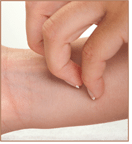 by Grant A. Turner, BS; Stephanie Sutton, BA; and Ashish Sharma, MD
by Grant A. Turner, BS; Stephanie Sutton, BA; and Ashish Sharma, MD
Mr. Turner is a third year medical student, Ms. Sutton is a fourth year medical student, and Dr. Sharma is Associate Professor of Consult/Liaison Psychiatry; all from University of Nebraska Medical Center, Psychiatry Department, Omaha, Nebraska.
Innov Clin Neurosci. 2014;11(1–2):29–31
Funding: No funding was provided for the preparation of this manuscript.
Financial disclosures: The authors have no conflicts of interest relevant to the content of this article.
Key words: Excoriation disorder, aripiprazole, neurotic excoriations, skin-picking disorder, venlafaxine
Abstract
We present a case of a 21-year-old woman with excoriation disorder that was resistant to currently reported treatment options. Severe lesions were present on multiple sites of her body. The skin picking appeared to be associated with anxiety surrounding her current medical stay and medical condition. The addition of aripiprazole to the venlafaxine she was already taking resulted in resolution of her unconscious picking. This medication combination may be considered by clinicians in the future for treatment-resistant excoriation disorder as its side effect profile is favorable for patients who have failed first-line treatment options. Large-scale studies investigating the use of second generation antipsychotics combined with selective serotonin reuptake inhibitors/serotonin norepinephrine reuptake inhibitors for the treatment of excoriation disorder is recommended.
Introduction
Excoriation (skin-picking) disorder is also known as dermatillomania, psychogenic excoriation, and neurotic excoriation. Patients with excoriation disorder often present first to a dermatologist rather than a psychiatrist. Excoriation disorder has changed recently from being considered a residual diagnosis related to impulse control in the Diagnostic and Statistical Manual of Mental Disorders, Fourth Edition, Text Revision to becoming a part of the obsessive compulsive range of disorders in the Diagnostic and Statistical Manual of Mental Disorders, Fifth Edition (DSM-5) with specific criteria for diagnosis. With this move, this disorder has also become more specifically characterized, and shows the importance of finding proper treatments for this psychiatric disorder.
DSM-5 criteria for excoriation disorder includes the requirement that recurrent skin picking causes skin lesions, that the patient is not able to consciously stop this picking, the picking causes significant distress, and finally that the picking is not caused secondary to another medical condition, drug, or another mental disorder.[1]
Excoriation disorder is often a diagnosis of exclusion, as true skin conditions should not be overlooked.[2] Skin lesions caused by this disorder often contain well-demarcated borders and are usually distributed on areas of the body that are easily reachable by the patient.[3] Common locations for excoriations include extensor surfaces of arms, anterior thighs, the face, fingers, and upper back.[3,4]
The prevalence of excoriation disorder in the general public is undetermined. However, it is believed that about two percent of patients in dermatology clinics have this condition.[5] Excoriation disorder is more common in the female gender (8:1 ratio of female to male) and has a mean age of presentation of 15 to 45 years old.[6] Analyses have shown that excoriation disorder is associated with underlying anxiety or depression in a majority of cases.[7] In fact, 48 to 68 percent of patients with excoriation disorder have been found to have a mood disorder, including major depression, bipolar disorder, or dysthymia.[6] And 41 to 65 percent of patients with excoriation disorder are found to have an anxiety disorder, including agoraphobia, social or specific phobia, obsessive compulsive disorder, posttraumatic stress disorder, panic disorder, or generalized anxiety disorder.[6] It has been shown that there is a higher incidence of bipolar disorder in patients with excoriation disorder.[8]
Treatment of excoriation disorder has been commonly regarded as difficult and has required augmentation strategies in the past. We present a treatment-resistant case of excoriation disorder successfully treated with a combination of aripiprazole and venlafaxine
Case Presentation
A 21-year-old Caucasian woman was admitted to the hospital for abdominal pain, fever, and irregular bowel movements. Her past medical history was significant for a small bowel transplant in 2011. The indication for transplant was intestinal pseudoobstruction and short-gut syndrome, which began in infancy. During the current hospital stay, her intestinal biopsy showed acute rejection of the transplant in the ileum. The psychiatry service was consulted for the patient’s anxiety, insomnia, and “picking of skin.” During the examination, multiple self-induced excoriations were noted. These were located on her right anteromedial thigh, ventral abdomen, and on the tips of several fingers.
The largest skin lesion was on the abdomen, measured 1.5 x 2.0 cm in diameter, and extended into the dermis. When asked why she was picking at her skin, the patient replied “I don’t even notice I am picking until my mom or a nurse brings it to my attention.” She said the skin picking was related to her anxiety and she picked at her skin both during the day and at night. She would wake up with wounds from her unconscious picking behavior during the night. While being interviewed, the patient picked at her fingers and caused them to bleed.
The patient had repeatedly tried to stop picking at her skin, but had been unsuccessful. Current medication included venlafaxine 225mg, which had been started six months prior for anxiety and depression. Diphenhydramine and lorazepam were initiated at this hospitalization for anxiety. Past medication trials included sertraline, amitriptyline, alprazolam, clonazapam, valproic acid, and pregabalin. All of these had failed to improve her mood and anxiety in the past. Her psychiatric history was positive for anxiety, depression, and insomnia.
Quetiapine and mirtazapine were both tried during this hospitalization to help decrease her anxiety and improve her mood. However, they did not relieve her symptoms of anxiety or her skin picking. Eventually aripiprazole was prescribed at 10mg by mouth at bedtime. Within 48 hours, the patient endorsed that aripiprazole greatly decreased her desire to pick at her skin. She stated her overall mood and anxiety had also improved. Her mother also attested to the resolution of neurotic excoriations. The psychiatry service observed that no new skin lesions were formed and the old lesions began healing. The patient was followed over the next three weeks and continued to endorse no return of her skin picking compulsions as well as a decreased level of anxiety compared to her pre-hospital baseline.
Discussion
Current first-line treatment for excoriation disorder depends on the underlying psychiatric issue. Mainstays of treatment are selective serotonin reuptake inhibitors (SSRIs), as they can reduce obsessive and depressive symptoms.[5] A double-blind, placebo-controlled study of fluoxetine used for neurotic excoriation showed it to be an effective treatment strategy.[9] Sertraline and escitalopram have also been shown to be effective.[10,11] Treatment can also include benzodiazepines for short-term therapy to reduce anxiety or tricyclic antidepressants such as doxepin.[5,12] Another possible treatment option is a mood stabilizer, such as lamotrigine, lithium, divalproex, and carbamazepine, but studies on their use have so far been lacking.[13]
Several case reports have implicated the sensation-seeking dopaminergic pathways as possible targets of medication in excoriation disorder, making the antipsychotics a medication class uniquely suited to help with excoriation disorder symptoms.[14] Aripiprazole, a member of the atypical antipsychotic medication class, is a first choice for specific scenarios because of its desirable lack of a strong side effect profile. Aripiprazole has been found to have decreased affinity for cholinergic, alpha-adrenergic, and histaminergic receptors, therefore causing less side effects than others in its class. Aripiprazole is also a dopamine partial agonist, in addition to being a 5-HT1a partial agonist and 5-HT2a antagonist. With its unique properties come the ability to increase the dosing of the medication without as many of the adverse side effects seen with other antipsychotic medications.[14]
Augmentation strategies for the treatment of excoriation disorder have been shown to be effective with haloperidol/fluvoxamine and olanzapine/fluoxetine combinations.[15,16] Two previous case reports have shown efficacy with using aripiprazole as adjunctive therapy with SSRIs/serotonin norepinephrine reuptake inhibitors (SNRIs).[14,17] Our report reaffirms this combination and expounds upon its use. Another augmentation strategy that has been found to be effective for treatment-resistant excoriation disorder is cognitive behavioral therapy (CBT).[6] CBT for excoriation disorder might include insight-oriented therapy, and requires a strong doctor-patient relationship, similar to the treatment of other obsessive compulsive related disorders.[6]
Conclusion
While there are many treatment options currently available for excoriation disorder, it is necessary to find and discuss additional options that can be used if the mainstays of treatment (monotherapy with an SSRI) are not effective. While each case is individualized and requires weighing of risks and benefits for each patient, our case suggests that aripiprazole, an atypical antipsychotic without many of the negative side effects (weight gain, tardive dyskinesia) of other antipsychotics, and venlafaxine, a relatively safe SNRI, can be used for treatment-resistant excoriation disorder. Now that excoriation disorder has been formally defined and placed in the DSM-5, we recommend research studies to evaluate aripiprazole as well as other antipsychotics as an augmentation strategy with SSRIs/SNRIs for the treatment of excoriation disorder.
References
1. American Psychiatric Association. Diagnostic and Statistical Manual of Mental Disorders, Fifth Edition. Arlington, VA: American Psychiatric Press Inc.; 2013:254–247
2. Anetakis Poulos G, Alghothani L, Bendo S, Zirwas MJ. Neurotic excoriations: a diagnosis of exclusion. J Clin Aesthet Dermatol. 2012;5(2):63–64.
3. Wong J, Nguyen T, Koo J. Primary psychiatric conditions: dermatitis artefacta, trichotillomania and neurotic excoriations. Indian J Dermatol. 2013;58(1):44–48.
4. Cry PR, Dreher GK. Neurotic excoriations. Am Fam Physician. 2001;64(12):1981–1984.
5. Heller MM, Koo JM. Neurotic excoriations, acne excoriee, and factitial dermatitis. In: Heller MM, Koo JY (eds). Contemporary Diagnosis and Management in Psychodermatology. Newton: Handbooks in Health Care Co; 2011;37–44.
6. Arnold L, Auchenbach MB, McElroy S. Psychogenic excoriation: clinical features, proposed diagnostic criteria, epidemiology, and approaches to treatment. CNS Drugs. 2001;15(5):351–359.
7. Misery L, Chastaing M, Tuboul S, et al. Psychogenic skin excoriations: diagnostic criteria, semiological analysis and psychiatric profiles. Acta derm Venereol. 2012;92(4):416–418.
8. Mutasim DF, Adams BB. The psychiatric profile of patients with psychogenic excoriation. J Am Acad Dermatol. 2009;61(4):611–613
9. Simeon D, Stein DJ, Gross S, Islam N, et al. A double-blind trial of fluoxetine in pathologic skin picking. J Clin Psychiatry. 1997;58:8:341–347.
10. Kalivas J, Kalivas L, Gilman D. Sertraline in the treatment of neurotic excoriations and related disorders. Arch Dermatol. 1996;132(5):589–590.
11. Pukadan D, Antony J, Mohandas E, et al. Use of escitalopram in psychogenic excoriation. Aust N Z J Psychiatry. 2008;42(5):435–436.
12. Harris BA, Sheretz EF, Flowers FP. Improvement of chronic neurotic excoriations with oral doxepin therapy. Int J Dermatol. 1987;26(8):541–543.
13. Gupta, M. Emotional regulation, dissociation, and the self-induced dermatoses: clinical features and implications for treatment with mood stabilizers. Clin Dermatol. 2013;31(1):110–117.
14. Curtis A, Richards R. The treatment of psychogenic excoriation and obsessive compulsive disorder using aripiprazole and fluoxetine. Ann Clin Psychiatry. 1997;19(3):199–200.
15. Luca M, Vecchio C, Luca A, Calandra C. Haloperidol augmentation of fluvoxamine in skin picking disorder: a case report. J Med Case Rep. 2012;6:219.
16. Christensen R. Olanzapine augmentation of fluoxetine in the treatment of pathological skin picking. Can J Psychiatry. 2004;49:11:788–789.
17. Carter WG, Shillcut SD. Aripiprazole augmentation of venlafaxine in the treatment of psychogenic excoriation. J Clin Psychiatry. 2016;67:1311.





